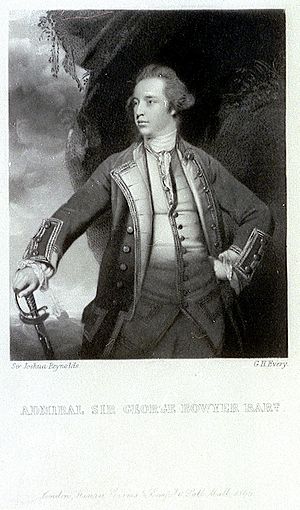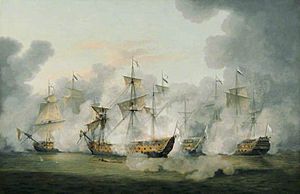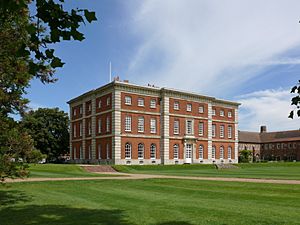Sir George Bowyer, 5th Baronet facts for kids
Quick facts for kids
Admiral Sir
George Bowyer
Bt
|
|
|---|---|

George Bowyer as a post-captain
|
|
| Born | Baptised 3 May 1740 Denham, Buckinghamshire |
| Died | 6 December 1800 Radley Hall, Oxfordshire |
| Allegiance | |
| Service/ |
|
| Years of service | 1751–1800 |
| Rank | Admiral of the Blue |
| Commands held | HMS Swift HMS Sheerness HMS Burford HMS Albion HMS Irresistible HMS Bellona HMS Boyne |
| Battles/wars | |
| Awards | Naval Gold Medal |
Admiral Sir George Bowyer, 5th and 1st Baronet (born 3 May 1740 – died 6 December 1800) was a brave officer in the Royal Navy. He lived during the 1700s and took part in many important wars.
He fought in the Seven Years' War, including the Battle of Minorca, the Raid on Rochefort, and the Siege of Louisbourg. Later, during the American Revolutionary War, he commanded the ship HMS Albion. He was part of the Battle of Grenada and the Battle of Martinique.
In 1793, George Bowyer became a rear-admiral. He fought bravely at the famous Glorious First of June battle in 1794, where he was badly injured and lost a leg. Because of his great service, he was given a special honor called a baronetcy. He became a full admiral in 1799. He also inherited another baronetcy from his brother that same year. Admiral Bowyer passed away in December 1800.
Contents
Starting Out: Early Career
George Bowyer was born in Denham, Buckinghamshire, and was baptised on 3 May 1740. He was the third son of Sir William Bowyer, 3rd Baronet.
He joined the Royal Navy when he was just 11 years old, on 11 May 1751. He started as a "captain's servant" on the ship HMS Glory. This was a common way for young boys to begin their naval careers. He then moved to the ship HMS Dolphin in 1752. On Dolphin, he sailed off the coast of West Africa and in the Mediterranean Sea.
In 1755, he became a midshipman on the ship HMS Princess Louisa. As a midshipman, he helped the officers and learned how to command a ship. He fought in the Battle of Minorca in May 1756.
After this, he served on other ships like HMS Lancaster and HMS Royal Anne. On Royal Anne, he took part in the Raid on Rochefort in September 1757. He passed his exam to become a lieutenant in February 1758. He was then sent to the West Indies to serve on HMS Nottingham. There, he fought in the Siege of Louisbourg in 1758.
In 1761, George Bowyer was promoted to commander. His first command was a small ship called HMS Swift. In June 1762, his ship was captured by a much larger French ship. After this, a special naval court (called a court martial) looked into what happened. They decided that Commander Bowyer had done everything he could to escape, so he was cleared of any blame.
Becoming a Post-Captain
Soon after, on 28 October 1762, Bowyer was promoted to post-captain. This was a very important rank in the navy. He commanded the ship HMS Sheerness in the Mediterranean Sea until the Seven Years' War ended in 1763.
He didn't have another command until the American Revolutionary War began. In 1776, he took command of HMS Burford. Then, in 1778, he took charge of the ship HMS Albion. He sailed Albion to North America and then to the West Indies.

On 6 July 1779, Captain Bowyer and Albion fought in the Battle of Grenada. He later joined Admiral Sir George Rodney's fleet. They fought several times against the French admiral de Guichen. One of these was the Battle of Martinique on 17 April 1780. In this battle, Admiral Rodney wanted his ships to focus their attack on specific French ships. Captain Bowyer understood this plan, but other officers got confused.
On 15 May, the two fleets met again. Albion was at the front of the British line. It faced heavy fire from fifteen French ships all at once! Captain Bowyer bravely steered his ship through this danger. He returned to England in 1781.
After some time, he commanded HMS Irresistible as a guardship in the Medway. A guardship protects a port or area. For this role, he was made a commodore, which is a temporary rank above captain. He later commanded HMS Bellona and the new ship HMS Boyne. Boyne was his last command as a post-captain.
Becoming an Admiral

On 1 February 1793, Bowyer was promoted to rear-admiral. He joined the Channel Fleet under Admiral Howe. He raised his flag (meaning he commanded from) on HMS Prince, and later on HMS Barfleur.
On 1 June 1794, the fleet fought the famous battle of the Glorious First of June. Admiral Bowyer was heavily involved in the fighting. Around 10 a.m. on that day, a cannonball hit him, and he lost his leg. His flag captain, Cuthbert Collingwood, caught him as he fell. Bowyer was taken below deck for surgery. Collingwood took over command for the rest of the battle.
For his bravery and service in this victory, Admiral Bowyer was given a baronetcy on 16 August. He also received a special Naval Gold Medal. Because of his injury, he could no longer actively serve at sea. However, he continued to be promoted. He became a vice-admiral in 1794 and a full admiral in 1799. He also received a pension of £1,000 a year for his injury.
In April 1799, he inherited another family baronetcy from his brother, William. Admiral Bowyer had inherited Radley Hall from his uncle in 1792. He lived there until he passed away on 9 December 1800. He was buried in the local church.
Political Life
In 1784, George Bowyer became a member of parliament for a place called Queenborough. This parliamentary seat was influenced by the Admiralty, which was the government department in charge of the navy.
As an MP, he focused on naval matters. He generally supported the government led by William Pitt the Younger. He gave his first speech in parliament on 18 June, defending the navy. He made nine other speeches, all about naval issues. He also joined a committee that looked into the defenses of important naval ports like Portsmouth and Plymouth. He left his seat in parliament in 1790.
Family Life
George Bowyer was married twice. His first wife was Margaret Price, who passed away in 1778. They did not have any children.
In 1782, he married Henrietta, the daughter of Admiral Sir Peircy Brett. Together, they had five children:
- Sir George Bowyer, 6th Baronet (born 1783)
- William Bowyer (born 1784), who became an army officer
- Henry Bowyer (born 1786), who became a church rector
- Henrietta Sawyer, who married Charles Sawyer
- Eliza Bowyer (born 1791)


